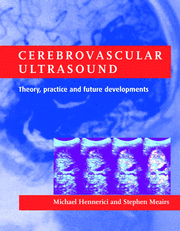Book contents
- Frontmatter
- Dedication
- Contents
- List of contributors
- Preface
- PART I ULTRASOUND PHYSICS, TECHNOLOGY AND HEMODYNAMICS
- 1 Introduction to Doppler ultrasound
- 2 Doppler technology
- 3 Principles and models of hemodynamics
- 4 Computational principles and models of hemodynamics
- 5 Flow patterns and arterial wall dynamics
- 6 Duplex and colour flow imaging
- 7 Misconceptions and artefacts in ultrasound examination of the carotid arteries
- PART II CLINICAL CEREBROVASCULAR ULTRASOUND
- PART III NEW AND FUTURE DEVELOPMENTS
- Index
7 - Misconceptions and artefacts in ultrasound examination of the carotid arteries
from PART I - ULTRASOUND PHYSICS, TECHNOLOGY AND HEMODYNAMICS
Published online by Cambridge University Press: 05 July 2014
- Frontmatter
- Dedication
- Contents
- List of contributors
- Preface
- PART I ULTRASOUND PHYSICS, TECHNOLOGY AND HEMODYNAMICS
- 1 Introduction to Doppler ultrasound
- 2 Doppler technology
- 3 Principles and models of hemodynamics
- 4 Computational principles and models of hemodynamics
- 5 Flow patterns and arterial wall dynamics
- 6 Duplex and colour flow imaging
- 7 Misconceptions and artefacts in ultrasound examination of the carotid arteries
- PART II CLINICAL CEREBROVASCULAR ULTRASOUND
- PART III NEW AND FUTURE DEVELOPMENTS
- Index
Summary
Sometimes carotid artery images appear to demonstrate atherosclerotic plaques with clarity. Sometimes the plaques seem obscure. A theoretical analysis of the potential problems with ultrasound examination suggests that ultrasound holds no promise for carotid plaque characterization. Yet, the examination of carotid artery stenosis with duplex Doppler ultrasound is one of the most reproducible examinations available. In this chapter we will try to sort out the misconceptions in ultrasound physics and examination methods from the observable facts and try to show the proper role of ultrasound in carotid stenosis and plaque evaluation.
There are three complementary methods of evaluating carotid stenosis: X-ray contrast angiography (including CT methods), duplex ultrasound, and magnetic resonance imaging (MRI). Conventional angiography shows only shadows of the arterial lumen. MRI can be used to characterize the lumen and the plaque, as can ultrasound. Although angiography is the ‘gold standard’, it will not be considered further as it can reveal nothing about plaque content. At first ultrasound and MRI seem to be competing technologies, but a quick comparison shows little overlap in their abilities (Table 7.1). Instead, the comparison shows that they can be complementing technologies. Thus, MRI should be used for the characterization of plaque constituents (Yuan et al., 1997, 1998; von Ingersleben et al., 1997), the measurement of stenotic cross-sectional areas and the evaluation of complex slowly changing flows; ultrasound should be used for the measurement of media thickness, the measurement of small motions, and the characterization of rapidly changing flow velocities.
- Type
- Chapter
- Information
- Cerebrovascular UltrasoundTheory, Practice and Future Developments, pp. 101 - 114Publisher: Cambridge University PressPrint publication year: 2001



